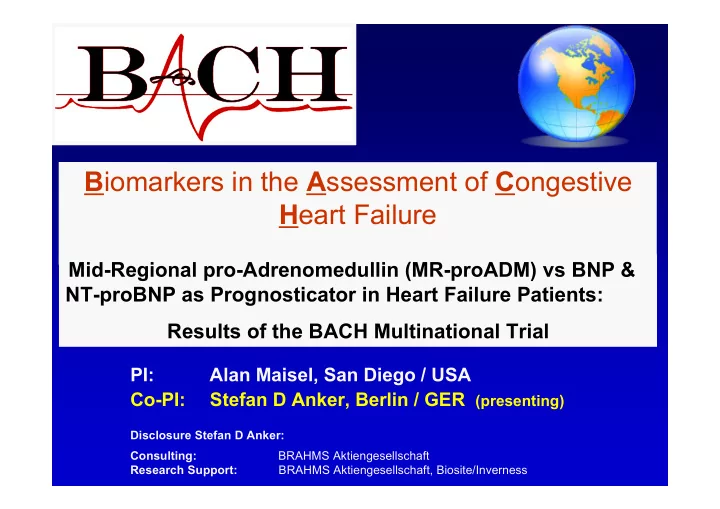

B iomarkers in the A ssessment of C ongestive H eart Failure Mid-Regional pro-Adrenomedullin (MR-proADM) vs BNP & NT-proBNP as Prognosticator in Heart Failure Patients: Results of the BACH Multinational Trial PI: Alan Maisel, San Diego / USA Co-PI: Stefan D Anker, Berlin / GER (presenting) Disclosure Stefan D Anker: Consulting: BRAHMS Aktiengesellschaft Research Support: BRAHMS Aktiengesellschaft, Biosite/Inverness
MR-proADM is a reliable surrogate marker of Adrenomedullin Adrenomedullin: - Peptide hormone consisting of 52 amino acids - vasodilator, important for microcirculation & endothelial (dys)function - quantification of ADM could be helpful in cardiac diseases (CHF, MI, ACS,...) as well as in others (like infections & kidney disease) - ADM measurement is not suitable for clinical routine diagnosis assessment due to its ex vivo instability (immediate binding to receptors, 22min half-life time) - mid regional pro-ADM (MR-proADM) is a stable and reliable surrogate marker for ADM release 1 24 71 74 125 164 N-terminal PAMP Adrenomedullin peptide O Pro-Adrenomedullin 24 – 71 // -C NH 2 - ELRMSSSYPTGLADVKAGPAQTLIRPQDMKGASRSPEDSSPDAARIRV \ MR-proADM OH Struck J et al., Peptides. 2004; Morgenthaler NG et al., Clin Chem. 2005
Methods QUESTIONS: • What is the preferred (best) clinical tool for prognostication in HF? • Does measuring of MR-proADM, better predict prognosis than BNP or NT-proBNP? • 1° endpoint: Is MR-proADM superior in predicting 90-day mortality compared to BNP? PATIENTS & FOLLOW-UP • Patients included who presented to ED with SOB not from trauma, or obvious MI & not on dialysis – then MD assessment for heart failure • Follow-up for 90 days for survival, main outcome “All cause mortality within 90 days” • 15 enrolling centers (US, Europe, NZL), recruiting 1641 patients. • N=1641, Age 64±17 yrs, Female 48%, History of HF 36%, prior AMI 19%, Diabetes 29%, BMI 29±8 kg/m 2 Enrolled 1641 Adjudicated Non-AHF AHF Diagnosis 1073 568 Admitted Discharged Deceased Admitted Discharged Transfers ED 443 628 2 477 89 2 Disposition
Primary Endpoint = Successful - MR-proADM & mortality in AHF Prognostic Accuracy: MR-proADM 73.5% vs BNP 60.8% (p<0.001) vs NT-proBNP 63.6% (p<0.001) Results of Cox regression with continuous predictors: MR-proADM is superior to BNP and NT-proBNP for predicting 90-day mortality (Cox regression). AUC 30 days 90 days Predictor (univariate) Chi 2 Statistic MR-proADM 0.739 0.674 p c index NT-proBNP 0.641 0.664 log MR-proADM 31.0 <0.001 0.669 BNP 0.555 0.606 log BNP 7.1 0.008 0.596 log NT-proBNP 17.1 <0.001 0.654 MR-proADM adds significantly to BNP or NT- proBNP, however neither BNP nor NT-proBNP add to MR-proADM. Chi 2 Statistic p adding MR-proADM to BNP 23.9 <0.0001 adding MR-proADM to NT-proBNP 15.3 <0.0001 adding BNP to MR-proADM 0.0 0.906 adding NT-proBNP to MR-proADM 1.1 0.291
Survival in AHF - Troponin adjustment & MR-proADM Quartiles Troponin values were available in 511 of 568 HF patients – in 107 (20.9%) patients they were elevated (i.e. above local normal range). Shown are results of 3-marker models. Conclusion: MR-proADM provides independent prognostic utility, but BNP & NT-proBNP do not. Predictor (multivariable) HR 95% CI p Predictor (multivariable) HR 95% CI p log MR-proADM 8.5 2.7-26.5 <0.001 log MR-proADM 7.5 2.1-26.4 <0.001 log BNP 0.9 0.5-1.9 0.812 log NT-proBNP 1.1 0.6-2.2 0.295 Elevated Tn 2.6 1.5-4.5 <0.001 Elevated Tn 2.6 1.5-4.4 <0.001 Analysis of MR-proADM quartiles: 1.00 1.00 MR-proADM < 2.07 nmol/L Cumulative Survival 0.95 0.95 Cumulative Survival 1st-3rd 2nd 1st 3rd 0.90 0.90 HR 3.3– P<0.001 Risk is greatest in (95% CI 2.0-5.4) the highest quartile 0.85 0.85 of MR-proADM MR-proADM 0.80 0.80 ≥ 2.07 nmol/L 4th 4th 0.75 0.75 0 20 40 60 80 0 20 40 60 80 Days Days
Survival in all patients with SOB - Utility of MR-proADM Cox Regression Analysis: MR-proADM performs well in all SOB patients. 1.0 Chi 2 Statistic Predictor (univariate) p c index log MR-proADM 129.5 <0.0001 0.755 log BNP 60.1 <0.0001 0.691 0.8 log NT-proBNP 83.7 <0.0001 0.721 Sensitivity 0.6 MR-proADM is superior to BNP and NT-proBNP. 0.4 Chi 2 Statistic p Measurement AUC 95% CI p Measurement AUC 95% CI p adding MR-proADM to BNP 69.4 <0.0001 0.2 MR-proADM MR-proADM 0.761 0.719-0.803 <0.0001 0.762 0.721-0.804 <0.0001 BNP 0.698 0.654-0.742 <0.0001 adding MR-proADM to NT-proBNP 46.6 <0.0001 BNP 0.699 0.655-0.743 <0.0001 NT-proBNP 0.729 0.685-0.773 <0.0001 NT-proBNP 0.729 0.685-0.773 <0.0001 adding BNP to MR-proADM 0.1 0.731 0.0 adding NT-proBNP to MR-proADM 1.5 0.229 0.0 0.2 0.4 0.6 0.8 1.0 1 - Specificity
Survival in patients without AHF - Utility of MR-proADM 1.00 AHF patients Non-AHF Cumulative Survival 0.95 AUC optimal cut point (90 days) from ROC MR-proADM < 1.985 nmol/l AHF 0.90 MR-proADM 0.674 1.985 nmol/l 0.85 Elevated MR-proADM is strongly prognostic in 0.80 AHF patients with and without 0.75 MR-proADM ≥ 1.985 nmol/L AHF – even more so in non-AHF than in AHF 0.70 Non-AHF (interaction p=0.005). 0.65 Days 0 20 40 60 80 Diagnosis MR-proADM HR 95% CI p low < 1.985 1 reference Non-AHF high > 1.985 8.6 5.1-14.4 <0.001 low < 1.985 1.7 1.1-2.7 0.027 AHF high > 1.985 5.7 3.6-8.9 <0.001
Summary • MR-proADM is a strong prognosticator in patients with AHF and in patients presenting with SOB. • MR-proADM is superior to BNP or NT-proBNP for predicting 90-day mortality, both in AHF as well as in all ED pts with SOB. • All these results are unaffected by adjustment for Troponin. • MR-proADM is particularly strong in predicting short-term prognosis within 4 weeks after assessment. • MR-proADM can significantly improve risk stratification over BNP or NT-proBNP. • Assessment of MR-proADM can help to identify patients who should “move to the front of the line” of medical care.
Recommend
More recommend